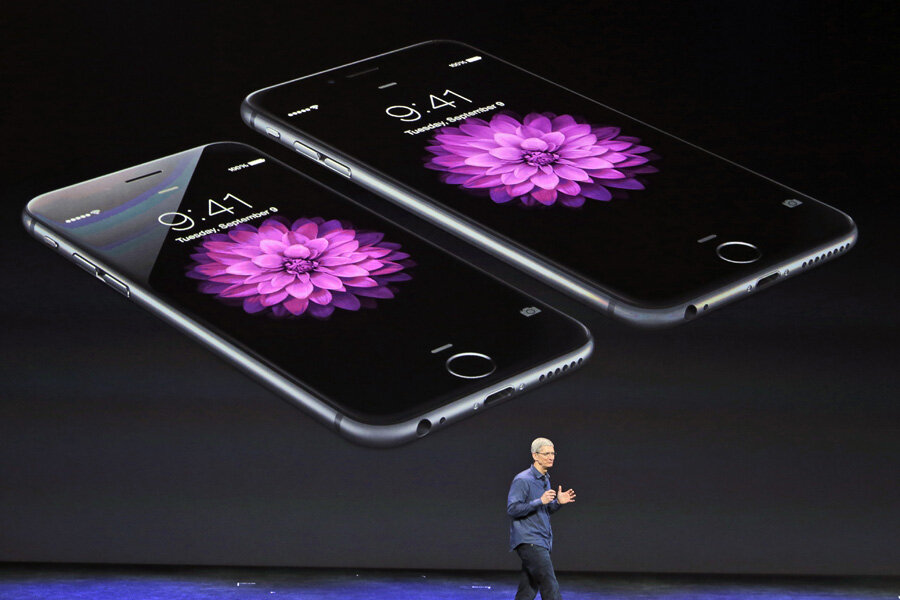What is Apple Pay and just how safe is it?
As Apple-mania continues following the announcement of two large-screen iPhones and the Apple Watch, questions are beginning to mount. The watch will be available early next year, but the phones become widely available next week. And although the specs on these phones are enough to impress even jaded technophiles – bigger screens with wide-angle viewing, retina HD display, enhanced video features – it's the new services offered that's got people talking. Principally, a new mobile payments system on the iPhone 6 that Apple promises will make wallets obsolete.
During Tuesday's launch event in Cupertino, Calif., Apple executives emphasized that the traditional wallets people normally carry around are, in fact, too clunky and cumbersome for daily life in 2014. The way Apple views it, customers shouldn't have to waste precious moments fumbling with wallets or purses, searching for the correct credit card. Like so much else in people's digital lives, the purchasing process should be available "with a single touch," right on our phones.
Apple's has already signed deals with credit card companies Visa, MasterCard, and American Express. Retailers include Target, Walgreens, and Macy's along with such restaurant chains as McDonald's, Subway, and Starbucks.
Using a Near Field Communication (NFC) chip installed on the iPhone 6, users need only hold the phone to a sensor with their finger on the phone's Touch ID reader to pay for items. No apps need be opened. According to Apple, one need not even glance at the screen to verify a payment has been sent. Instead, a subtle vibration and beep tells users their payment has processed. Users can also use Apple Pay to buy items in apps – think online shopping – with an Apple Pay icon that appears near the bottom of the screen.
Credit and debit cards are stored in the iPhone Passbook app, which has long been featured on iPhones as a means to store items like boarding passes, tickets, and coupons.
But along with storing valuable credit-card information comes concerns of security and privacy, which are only heightened in the wake of an iCloud hack that leaked personal celebrity photos onto the Web. Apple assures users they'll be able to take advantage of the phone's fingerprint-identification technology to prevent unwanted users from gaining access to the phone. During the keynote event, Eddy Cue, an Apple senior vice president, said Apple will not be recording valuable payment information, such as where people make purchases, how much they pay, and what they buy.
"We are not in the business of collecting your data," he said.
In fact, Apple insists that Pay is safer than traditional credit cards. As opposed to handing over a physical card, each card a user adds to his or her iPhone receives a unique device account number. Those numbers are encrypted and stored in a chip on the iPhone. Then, along with a security code, the account number is used to make a payment. A retailer never sees the card number nor are the numbers stored on Apple servers, the company says.
As an example of mobile security, this feature could help cut down on common credit card theft in which a retail employee could keep a copy of a customer's card information, says Domingo Guerra, president of the mobile security company Appthority.
"Now the teller won't even see the credit card," he says. "The user doesn't have to produce a card or an ID."
And because Apple only recognizes users' devices via a 16-digit pin that represents the card information stored at a company like Visa or MasterCard, this procedure is no different than relying on the pieces of plastic typically lining consumers' wallets. Individuals' financial information is "never stored in your phones," Jorn Lambert, group head of Emerging Payments at MasterCard, told Newsweek.
Until now, mobile payments have yet to take off in the mainstream. This is in part because previous mobile payment services were difficult to use, but also because other similar services didn't do the same kind of marketing or develop the same types of partnerships with credit card and retail companies that Apple has done. Google released Google Wallet, a mobile payment system for phones using its Android operating system, in 2011. But it has yet to take off as a widespread form of payment, despite working with MasterCard and Visa.
In addition, Apple has the added benefit of releasing its service later than the competition. Consumers and businesses alike are a bit more accustomed to the idea of paying with their phones and NFC technology has become more common. This timing plays into Apple's favor, Mr. Guerra says, who also adds that consumer concern will likely be assuaged knowing their actual card information will not be routinely handed over with transactions.
"There are a lot of known concerns about using our credit cards every day to swipe and make payments," he says. "So this looks like a good move in that it's not drawing the actual credit card information, it's just a secure token."






